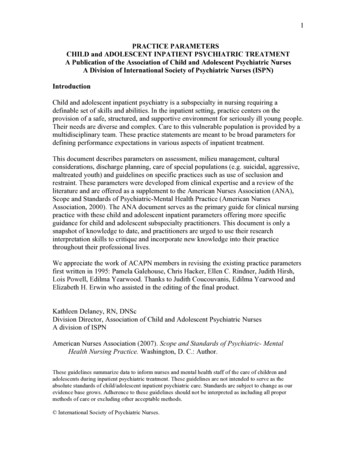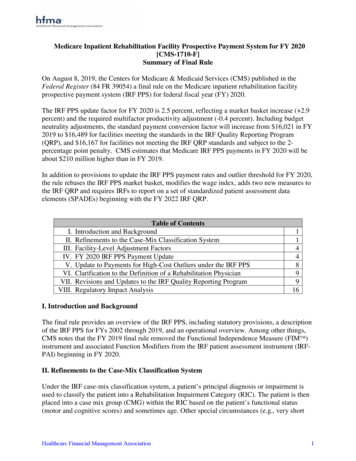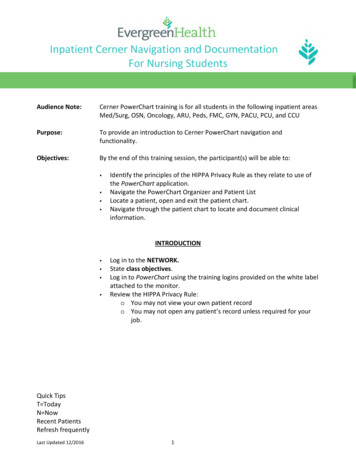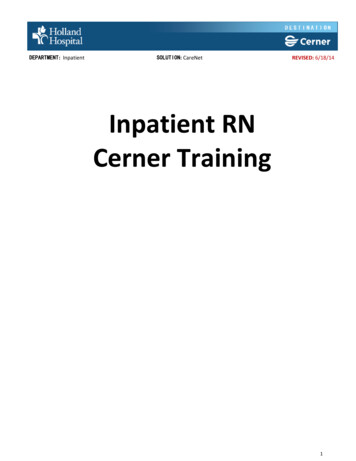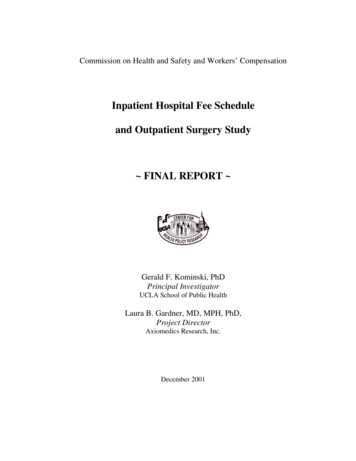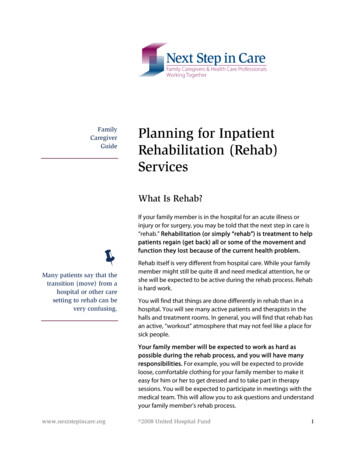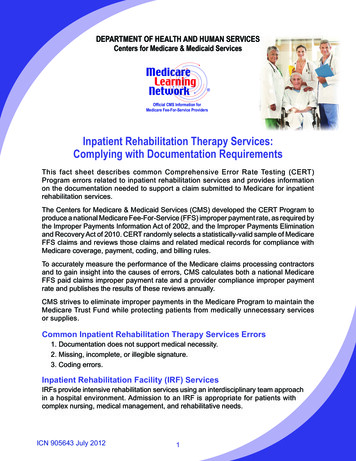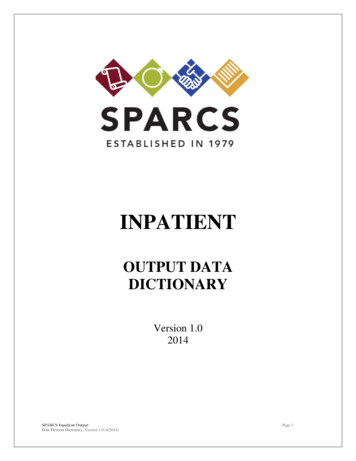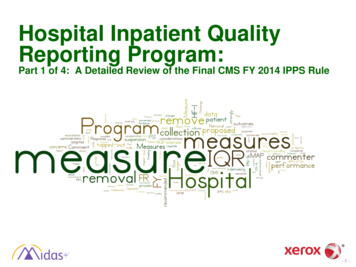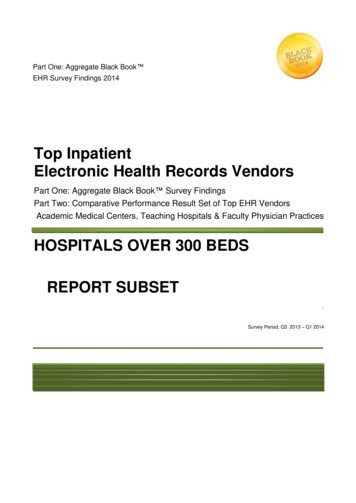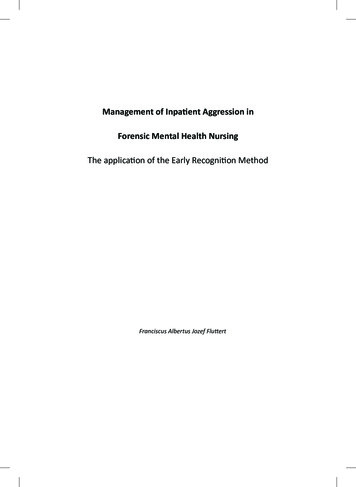
Transcription
Management of Inpatient Aggression inForensic Mental Health NursingThe application of the Early Recognition MethodFranciscus Albertus Jozef Fluttert
Copyright 2010 F.A.J. Fluttert, Arnhem, The NetherlandsManagement of Inpatient Aggression in Forensic Mental Health NursingThe application of the Early Recognition MethodThesis University of Utrecht, The Netherlands, including a summary in DutchAll rights reserved, including the right of reproduction in whole or in part in any formISBN:978-94-6108-116-2Printed byGildeprint Drukkerijen - Enschede, The NetherlandsCover design Kerliai LetworyFunded byFPC Dr. S. Van Mesdag
Management of Inpatient Aggressionin Forensic Mental Health NursingThe application of the Early Recognition MethodManagement van agressiein de forensische psychiatrische verplegingDe toepassing van de Methode Vroegsignalering(met een samenvatting in het Nederlands)Proefschriftter verkrijging van de graad van doctor aan de Universiteit Utrecht op gezag vande rector magnificus, prof.dr. J.C. Stoof, ingevolge het besluit van het college voorpromoties in het openbaar te verdedigen op dinsdag 11 januari 2011 des middagste 2.30 uurdoorFranciscus Albertus Jozef Fluttertgeboren op 28 februari 1962 te Hengelo (O)
Promotoren:Prof.dr. M.H.F. GrypdonckProf.dr. H.L.I. NijmanCo-promotor:Dr. B. van MeijelDit proefschrift werd (mede) mogelijk gemaakt met steun van Prof.dr. S. Bjørkly.
ContentsChapter 1General IntroductionChapter 2Risk Management by Early Recognition of Warning Signs719In Patients in Forensic Psychiatric Care.Chapter 3Preventing aggressive incidents and seclusions in39forensic care by means of the ‘Early Recognition Method’.Chapter 4The Development of the Forensic Early Warning61Signs of Aggression Inventory: Preliminary findings:Towards a Better Management of Inpatient Aggression.Chapter 5Early signs of inpatient aggression in forensic psychiatry:79an empirical investigation with the Forensic Early Signs ofAggression Inventory.Chapter 6Detached Concern of Forensic Mental Health Nurses in99Therapeutic Relationship With Patients: The Applicationof the Early Recognition Method Related to Detached Concern.Chapter 7General Discussion119Chapter 8Summary133Nederlandse samenvatting143Dankwoord (Acknowledgement)155Curriculum vitae163
Chapter 1General Introduction
Chapter 1INTRODUCTIONForensic mental health nurses work in a very dynamic field. Their mainconcerns are ‘security versus therapy’, ‘dangerousness’ and ‘management ofviolence’(Mason & Lovell 2008, Mason, King & Dulson 2009).On the interface of securityand treatment professionals in forensic mental health care are confronted with twoconflicting perspectives, namely the necessity of psychiatric treatment and care onthe one hand, and the public outcry for more severe restrictions to prevent societyfrom risk behaviour of the patient on the other hand. Nurses are members of amultidisciplinary treatment team in which therapeutic goals are set with emphasison the management of violence and the path to future rehabilitation. At the sametime these nurses fulfill a prominent role regarding safety; they prevent patientscausing dangerous situations, e.g., threatening or abusing others(Caplan 1993, Martin2001, Mason & Lovell 2008). Within this context of treatment and security, forensic mentalhealth nurses in particular are confronted on a daily basis with mentally disturbedpatients who are involuntary admitted to a place where they don’t want to stay.These patients live in groups on forensic units in which many interactions betweenpatients and nurses take place under sometimes stressful conditions (Martin & Daffern2006). Forensic patients must learn to cope with their own disturbing behaviours andwith those of their fellow patients. One of the treatment goals is to develop thecapacity to participate constructively in social interactions with fellow patients andwith nurses, e.g., participating in ward meetings with other patients (Rask & Levander2001).Nurses have to manage the interactions within the therapeutic environmentin order to create and maintain a safe living and learning environment for allpatients. Nurses invest in building a therapeutic relationship with patients to workcollaboratively on these goals and to tailor nursing care to the individual problems andneeds of patients (Rask & Brunt 2006, Mason & Lovell 2008). In this process the occurrenceof aggressive incidents causes threatening and sometimes even dangerous situationson the wards.Aggression and violent behaviours are complex phenomena, both definedas behaviours which are threatening or harmful to self, others or property. In forensic8
General Introductionliterature both terms are used, often as synonyms. There is no uniform definitionof aggression or violence(Abderhalden et al. 2008).The World Health Organizationdefined violence rather comprehensively as : “The intentional use of physical forceof power, threatened or actual, against oneself, another person, or against a groupor community, that either results in or has a high likelihood of resulting in injury,death, psychological harm, maldevelopment or deprivation”(Krug,2002, p. 5).Thisthesis predominantly uses the term aggression to describe patients’ behaviours.Palmstierna & Wistedt (2000) explained that aggression could be described byits expressed behaviour and by its inner experienced emotions. However theconceptual problem with aggression is more semantically rooted. They proposethe following dimensions in categorizing aggression: (1) inner experience versusoutward behaviour, (2) aggressor’s view versus observer’s view, and (3) persistentstate versus episodically occurrence. These dimensions might be helpful in bothclinical practice and research to analyze the nature of concrete aggressive behavioursand the way it develops over time. This thesis uses the term aggression as definedby Morrison (1990): Aggression is “any verbal, non-verbal, or physical behaviourthat is threatening (to self, others or property), or physical behaviour that actuallydoes harm (to self, others, or property)”. This definition is also mentioned in theStaff Observation Aggression Scale Revised [SOAS-R] (Nijman et al. 1999), which is oneof the main instruments we used in our study (see Chapter 3). Nevertheless, thecategorization given by Palmstierna & Wistedt (2000) may be helpful in the furtherexploration of precursors of aggression in forensic patients.When forensic patients are convicted, the court assesses them as notfully accountable for the offence they committed due to their psychiatric disorder.For most of the forensic patients the core problem is to control their aggression(Daffern & Howells 2009, Vitacco et al. 2009).Aggression often occurs in situations whenpatient’s needs are not fully met and anger and frustration arises. The occurrenceof aggression is associated with the complex interaction of both intrapersonal andinterpersonal factors, which we briefly will address in order to clarify how aggressioncould be understood. In our understanding of aggression, several intrapersonal9
Chapter 1factors are related to factors within the social context in which the patients functions,such as poverty, stressful life-events and victimization (Hiday 1997). When looking atviolence at the level of the individual patient, from the theory of social competenceBartels (2001) states that patient’s individual perceptions and reactions to eventsare influenced by personality characteristics, life experiences and interpersonal skills.So-called core beliefs (or personally based convictions) appear to play a profoundrole in the shaping of reactions to events. Apart from that, forensic researcherssuggest that when patients with schizophrenia experience feelings of threat andloss of control, the so-called ‘threat control-override symptoms’, these feelings areassociated with aggressive behaviours(Link, Stueve & Phelan 1998).Deficits in both theintrapersonal as interpersonal factors, in combination with stressful environmentalfactors, may contribute to patients’ vulnerability for aggressive responses. This notionis important for nurses who apply aggression management strategies because theyneed to be aware that patients’ incapability to control their aggression is a complexphenomenon.Patients who are admitted to forensic care often don’t succeed in controllingtheir aggressive behaviours. In forensic psychiatry the occurrence of aggressiveincidents leads to threatening and sometimes even dangerous situations on thewards. Frequently restrictive measures are applied by nursing staff, e.g. seclusion, inorder to control patients’ aggressive behaviour and to avoid danger and harm. Thecore message is that aggression is not allowed, but generally not much effort is madeto learn from previous events of aggression. However, this learning process is ofutmost importance to enhance a better self -management of aggression by forensicpatients. When patients are able to recognize and control the precursors of aggression,this could help them to carry out stabilizing actions in order to gain control overtheir behaviours and thus prevent aggressive incidents to occur. Additionally, whenpatients, while admitted at inpatient wards, succeed to manage their aggression, thetransfer to the rehabilitation phase is more likely to become the next treatment step.Aggression management strategies are most likely to be successful when patients10
General Introductionfeel accepted and are treated as individuals with characteristics which are valuable toacknowledge and to explore, even in case of aggression (Meehan, McIntosh & Bergen 2006).Patients’ (self)-management of aggression, i.e. those activities which patients initiateto control their aggressive impulses, should be an important issue during treatment.A profound insight into patient’s vulnerability to cope with stressfulsituations (e.g., due to delusions), and into the developmental process of aggression,is essential in the dynamic interactional understanding of violence(Bjørkly 2006).Sofar, forensic researchers have mainly made efforts to identify precursors of inpatientaggression on the basis of clinically dynamic factors by means of risk assessmentinstruments (Almvik, Woods & Rasmussen 2000, Ogloff & Daffern 2006, McDermott et al. 2009, Dolanet al. 2008).By applying these instruments nurses can observe and record precursorsof aggression by patients in daily ward situations and thereby gain knowledge of thelikelihood of aggression by the individual patient. Despite these efforts, the onset ofaggression and the escalation from mild forms of agitation into full-blown aggressionremains unclear. An important limitation of using risk assessment instruments is thatpatients generally do not play an active role in these forms of risk management andhence their capacities of self-management to prevent aggression is not addressed.One would expect, that risk management strategies guiding the nurses in teachingpatients these (self)-management skills constitute an important part of forensicmental health nursing working models, however, these strategies are currentlyhardly available (Bjørkly 2004, Fluttert et al. 2008).A step towards a better (self)management of patients’ aggression may bethe development of strategies for a joint effort of mental health professionals andpatients to (1) recognize the individual early warning signs of aggression in the firstphase in which they occur , and by this (2) to execute preventive actions to minimizethe risk of actual occurrence of aggression. Early warning signs of aggression can bedefined as changes in individual, thoughts, perceptions, feelings and behaviours ofthe patient that precipitate aggressive behaviour (Fluttert et al. 2008, van Meijel et al. 2006).Early warning signs represent a continuum from the very early stage of deteriorating11
Chapter 1behaviour (e.g. increasing suspiciousness) until the phase of deterioration proximalto aggression (e.g. increasing anger). When early warning signs are recognized,intervention strategies can be applied to diffuse the threat of aggression and therebyto restore patient’s equilibrium. Stabilizing interventions can be carried out by thepatient himself, but also by others, e.g., nurses.The quality of the working alliance between nurses and patients is a majordeterminant of the successful application of risk management strategies in forensiccare(Rask & Brunt 2006).Within a safe atmosphere, nurses encourage patients, in asystematic way, to discuss their perceptions and behaviours which could be identifiedas precursors of aggression. Only then, when the patient experiences constructiveinteractions and communication with the professional, the likelihood increases thatpatients will participate actively and be motivated in risk management interventions,such as the Early Recognition Method [ERM].So far we described in the context of forensic nursing, how inpatientaggression could be comprehended and how risk management strategies maycontribute to the management of aggression. Before further explaining the content ofthis thesis, the history of the ERM is outlined in order to gain a better understandingof how the ERM was elaborated. Birchwood (2000) developed the early interventionmodel for patients with schizophrenia to detect their early signs of psychosis. Thebasic idea is that when patients with schizophrenia (often collaboratively withrelatives and professionals) focus on their personal early signs of psychotic relapse,this would contribute to a better (self)management of (pre)psychotic behaviours.Special attention is paid to the notion that patient’s deterioration towards psychosesis very personal in nature. For this reason it is important to accurately reconstructthe earlier processes of psychotic relapse, so as to determine the specific individualprofile of early signs of psychosis. Birchwood refers to this profile as a so-called‘relapse signature’ (Birchwood 2000). It serves as a personalized signature to recognizethe very specific development of psychosis in one patient. The early recognition ofthese signs offers possibilities for early interventions, finally aiming at the preventionof severe psychotic episodes. Based on this notion, van Meijel et al. (2006) developed12
General Introductionfor nursing practice ‘The protocol for the application of the early recognition methodin patients with schizophrenia’. This protocol was applied and studied in nursingpractice on feasibility and effectiveness(van Meijel et al. 2006).Fluttert et al. (2002)modified this protocol in order to develop a risk management method for forensicmental health nurses aiming to prevent inpatient aggression in forensic patients withvarious diagnosis.SCOPE OF THIS THESISIn this thesis it is explained how the Early Recognition Method [ERM](Fluttert et al. 2008) may assist forensic mental health nurses to collaborate withtheir patients in the identification of early warning signs of aggression and in theexecution of interventions with the aim of preventing the occurrence of severeaggression incidents.In Chapter 2 the concept of early recognition for forensic mental healthnursing is clarified. It is explained how patients’ deteriorating behaviour towardsaggression is influenced by intrapersonal, interpersonal and environmental factors.By using the social competence model it is clarified how in the case of aggression,patients may lack the skills they require to filter events they encounter. The notion ofrelapse signature, as we described before, is underlined to be important in order toidentify and describe patient’ personalized early warning signs.In Chapter 3 we describe the intervention study of ERM in patients admittedto a highly secured forensic hospital. By applying ERM, nurses and patients evaluateand explore patient’s individual pattern of deterioration by describing in detail hisearly warning signs of aggression. By applying ERM in the total population of thehospital under study, we expect this to contribute to a decrease of inpatient incidents.A naturalistic one-way case cross-over design is used to study the relation betweenthe application of the ERM and inpatient aggression. The outcome measures are thenumber of seclusions and the severity of inpatient incidents by means of the StaffObservation Scale Revised version (Nijman et al 1999, Nijman & Palmstierna 2002).13
Chapter 1Chapter 4 describes the development and application of the Forensic EarlySigns of Aggression Inventory [FESAI]in forensic care. The FESAI is based on thequalitative analyses of descriptions of early warnings signs which were found in theearly detection plans of two forensic hospitals. In current clinical practice there is,to our knowledge, a lack of instruments or tools to support patients and nurses intheir joint effort to assess the most relevant early warning signs of aggression. TheForensic Early Signs of Aggression Inventory [FESAI] is meant to assist both patientand nurse in their endeavors to apply the Early Recognition Method. Thereby nurseand patient together assess which items of the FESAI represent the patient’s earlywarnings sign of aggression. The next step is the nurse and patient to formulate theearly warning signs of aggression and elaborate them in the Early Detection Plan.Chapter 5 presents the descriptive study in which early warning signs ofpatients of two forensic hospitals are scored on the FESAI. Aim of this study is toobtain a better insight in the prevalence of early warning signs in the patient groupof the hospital under study as a whole, and in specific subgroups of patients withspecific diagnoses (schizophrenia, personality disorder), types of offences and forpsychopathy.The concept detached concern is explained in Chapter 6. The nature andquality of the interaction between nurses and patients depends – among other - onnurses’ skills to neutralize the emotional appeal of patients by an attitude of bothobjectivity and emotional involvement, referred to as detached concern. The PatientContact Questionnaire [PCQ] measures the degree of detachment or concern ofnurses to their patients. In a pre-post study the PCQ is applied in nurses working withERM, aiming to gain insight into the relation between detached concern and ERM.Comparisons are carried out for all nurses, and for sub-groups of nurses with regardto gender, education level, years of working experience and patient populations.Finally in Chapter 7 the findings and limitations of this thesis are discussed.Directions for future research are described.14
General IntroductionREFERENCES1.Abderhalden C., Needham I, Dassen Th., Halfens R., H-J Haug, Fischer J. (2008). Structured riskassessment and violence in acute psychiatric wards: randomised controlled trail. The British Journalof Psychiatry, 193, 44-50.2.Almvik, R., Woods, Ph., & Rasmussen, K. (2000). The Bröset Violence Checklist: sensitivity, specificity,and interrater reliability. Journal of Interpersonal Violence, 15, 1284-12963.Bartels, A.A.J. (2001). The model of social competence in the treatment of forensic youth psychiatry, anin-depth study. In: Antisocial behaviour of youngsters. Determinants and interventions. (Het socialecompetentiemodel in forensische jeugdpsychiatrische behandeling; verdieping en verbreding. In:Antisociaal gedrag bij jeugdigen. Determinanten en interventies). Lisse: Swet & Zeitlinger, 95-124(Ch.6)4.Birchwood, M. (2000) The critical period for early intervention. In: Birchwood, M., Fowler, D., &Jackson, C. Early intervention in psychosis. Chichester: J. Wiley & Sons.5.Bjørkly, S. (2004). Risk Management in Transition Between Forensic Institutions and the Community:A Literature Review and Introduction to a Milieu Treatment Approach. International Journal ofForensic Mental Health, 3 (1), 67- 75.6.Bjørkly, S. (2006). Empirical evidence of a relationship between insight and risk of violence in thementally ill - A review of
Patients who are admitted to forensic care often don’t succeed in controlling their aggressive behaviours. In forensic psychiatry the occurrence of aggressive incidents leads to threatening and sometimes even dangerous situations on the wards. Frequently restrictive measures are
